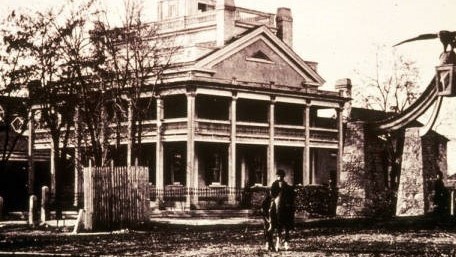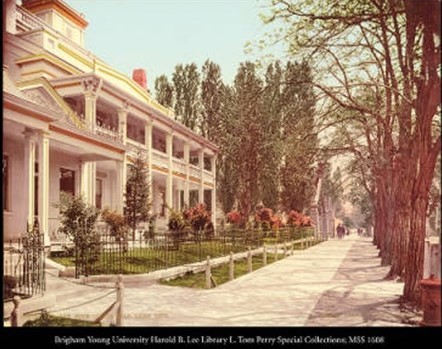The Beehive House of Brigham Young

“The home was undoubtedly planned in father’s mind through the happy memories of the beautiful colonial buildings in Vermont, his birthplace.” These words were penned by Clarissa Young Spencer, a daughter of Brigham Young, as she recalled her childhood in the Beehive House. The house served as Brigham Young’s primary residence following its completion in 1854 until his death.
Built in 1854 in Salt Lake City, Utah the Beehive house was home to Brigham Young, the 2nd president of the Church of Jesus Christ Latter-day Saints. It was designed in the Greek Revival style of architecture by Truman O. Angell. The original adobe walls were painted in a soft yellow, with green shutters over the windows, and a large front door with a silver door-knob. Spencer recalled how the house was used to entertain many guests. Such entertainments took place in what was called the “long hall.” The Utah State Historical Society records that the home welcomed visitors including “President Ulysses S. Grant, Emperor Dom Pedro of Brazil, General William T. Sherman, Ralph Waldo Emerson, Mark Twain, Jay Gould, Horace Greeley, and even the midget Tom Thumb and his tiny wife.” Young lived there with his wife Mary Ann Angell, who moved back to the White House, a separate property owned by Brigham Young in Salt Lake City “about a block east of the Lion House.” Lucy Ann Decker and her children moved into the house in 1860 and Lucy remained there until the end of Brigham’s life. The house was also home to men who worked on the Young estate as well as immigrant girls who had nowhere to go. Spencer recalled “Mother always used to say that everyone who didn’t have any other place to go was sent to her.”
Other features of the house included an attic, two parlors, Brigham Young’s room, a cellar, and a porch which Spencer recalls as a young woman was “a most convenient place to set out onto” to listen to serenading young men. A family store was also added at the back of the house where there had originally been a barn. The store was stocked to provide goods for the families of Young’s various wives. Brigham Young is known to have had at least 56 plural wives, as confirmed by the LDS Family History Archives. Only one wife and her children ever lived at the Beehive house at a time. Others lived in other homes owned by Young, many lived at the nearby Lion House. Spencer recorded that “there were usually about twelve families living in the Lion House.”
When Brigham Young died in 1877 Lucy Ann Decker was given the house in the estate settlement, and in 1888 she sold it to a son of Mary Ann Angell, John W. Young. In 1889, he began to remodel the house, which included a large Victorian addition in the back. However, he was a businessman, and when he suffered financial troubles, the house was foreclosed by the bank and sold at an auction to John Beck, who also eventually suffered financial troubles. The house was then purchased by the LDS church in 1899. Since that time it has served as the home of LDS Presidents Lorenzo Snow and Joseph F. Smith, then in 1920 it was given to the LDS Young Ladies Mutual Improvement Society to be run as a home for young women who came to the city for work or school. In 1959 it was converted into a museum.
Images


